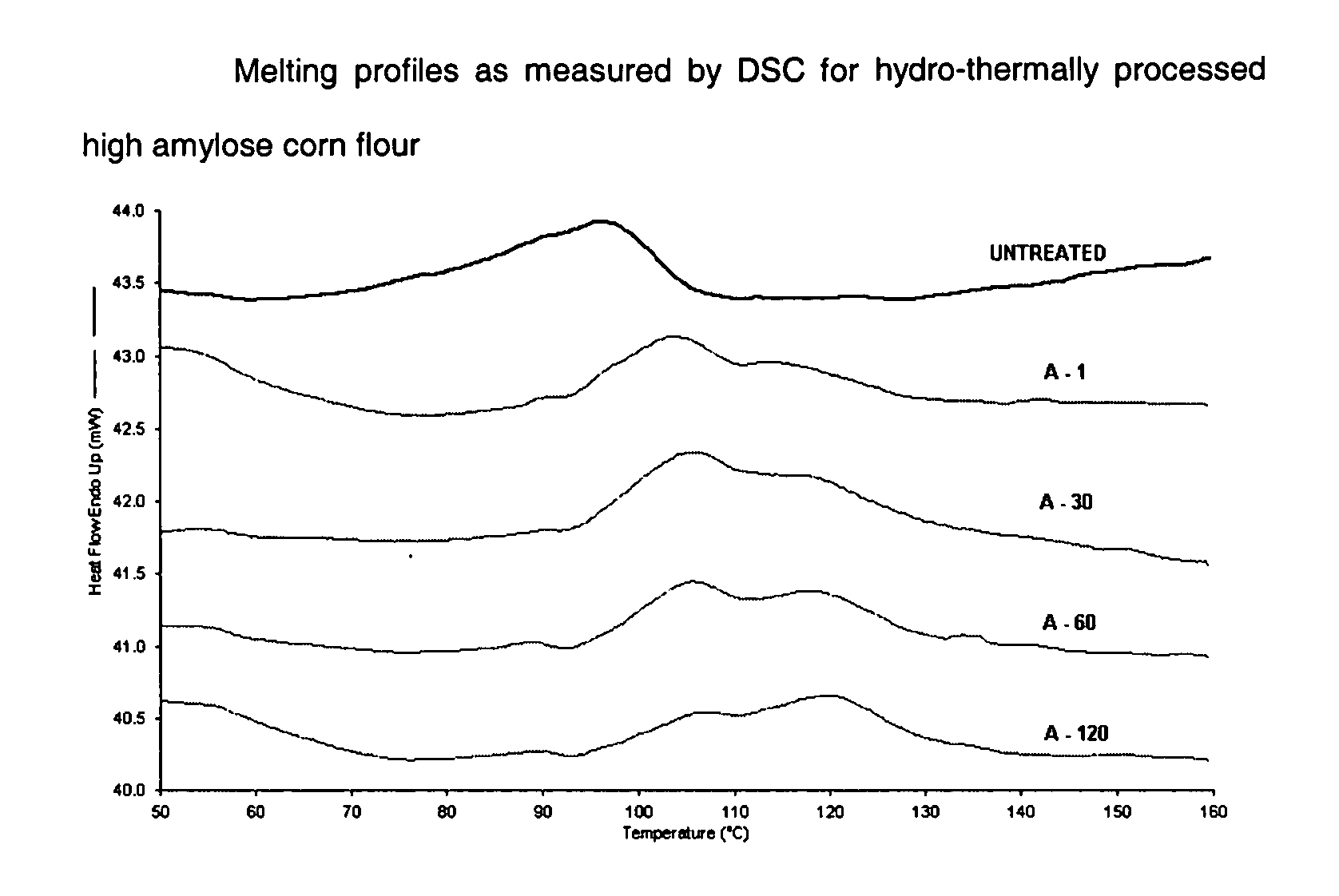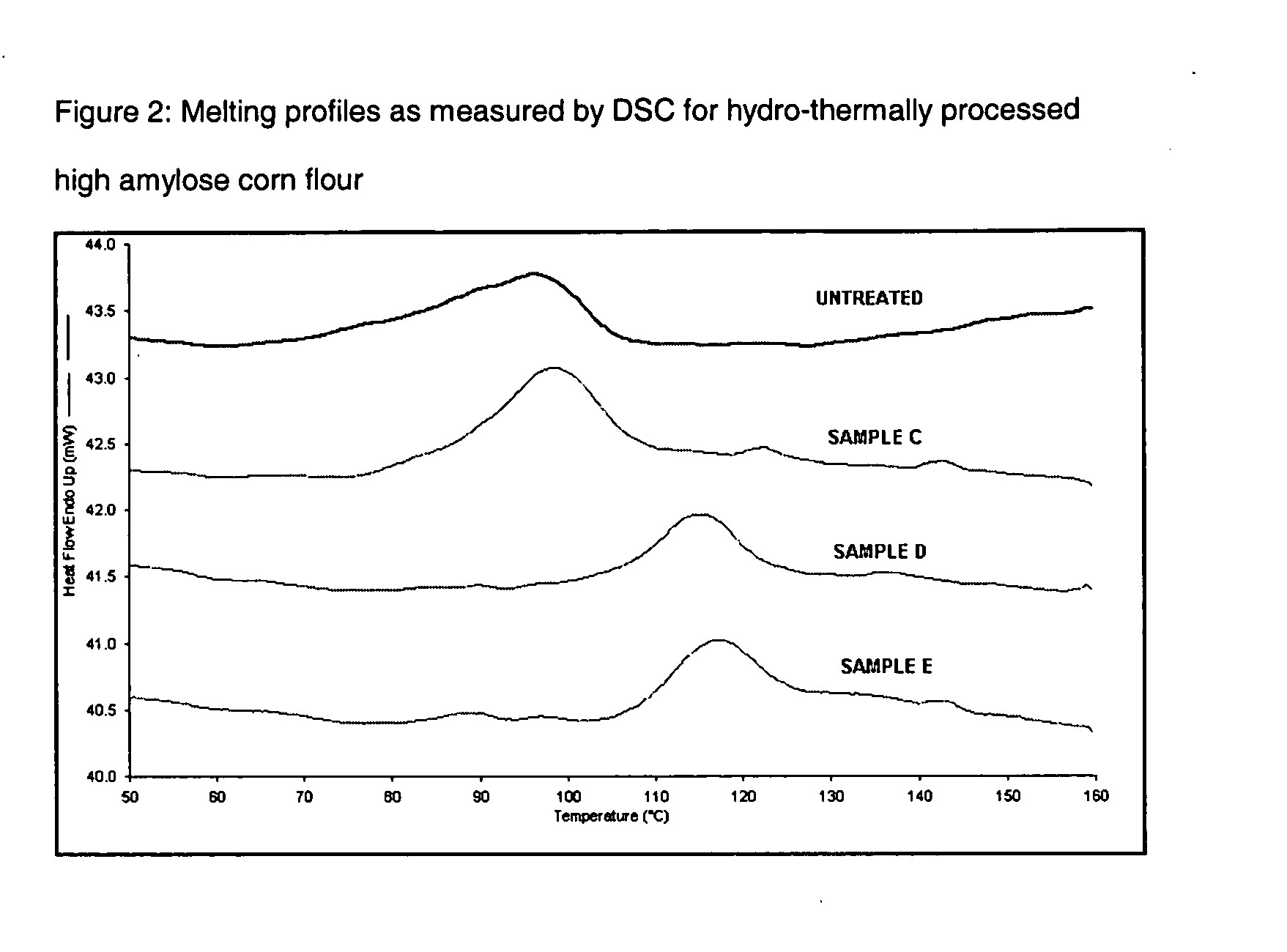Flour composition with increased total dietary fiber, process of making, and uses thereof
a technology of total dietary fiber and flour composition, which is applied in the field of making a flour composition with increased total dietary fiber, can solve the problems of significant time-consuming processing operations and substantial increase in total dietary fiber
- Summary
- Abstract
- Description
- Claims
- Application Information
AI Technical Summary
Benefits of technology
Problems solved by technology
Method used
Image
Examples
example 1
High Amylose Corn Flour with High TDF Produced via Hydrothermal Treatment at Short Processing Time: Relationship Between Processing Time and TDF Development
[0106] High amylose corn grain was used to produce degerminated high amylose corn flour via conventional dry milling. The dry milling process followed the typical description as outlined in the art and included grain cleaning, degermination followed by germ and bran separation and final steps of milling and sifting to obtain the target particle size. The composition had the following characteristics: 13.6% moisture, 10.2% protein, 1.8% ash and 6.0% fat. The particle size distribution was as follows: 55.3% on a 250 micron sieve, 18.3% on a 177 micron sieve, 17.5% on a 125 micron sieve and 8.9% thru a 125 micron sieve. The TDF of the high amylose corn flour was 31%.
[0107] The dry milled high amylose corn flour was hydro-thermally treated using a batch process ploughshare mixer and dryer (Model: 300HP Prestovac reactor manufacture...
example 2
Effect of Process Conditions on Melting Characteristics of Hydrothermally Treated High Amylose Corn Flour and Correlation to TDF Development
[0109] The “Sample A Series” from Example 1 as well as the untreated high amylose corn flour were characterized by DSC analysis to determine changes in melting behavior. The analytical procedure is described above. Table 2 summarizes the TDF data as well as the data that describe the melting behavior of the compositions. Further, the melting profiles are shown in FIG. 1. The data show that the onset temperature (To), the peak temperature (Tp) and the end temperature (Tc) increased with longer processing time. For To, the most significant increase was observed between the untreated flour and the 1 min at target temperature sample. For Tp, the most significant increases were observed for the “1 min at target temperature sample” (Sample A-1) and the change from 60 to 120 min. For Tc the most significant changes were observed for the “1 min at targ...
example 3
Effect of Process Conditions on Color Development in Hydrothermally Treated High Amylose Corn Flour
[0110] The “Sample A Series” described in Examples 1 and 2 as well as the untreated high amylose corn flour were analyzed by color using a Hunter Color Quest II spectrocolorimeter sphere model (Hunter Associates laboratory, Inc. Reston, Va., USA). The procedure measured the L- and the a—values. The L—value describes lightness on a scale from 0 to 100. A reduction in L—value expresses reduced lightness. The a—value, when positive, describes an increase in redness. The two values were used to describe an increase in browning that was observed for hydrothermally treated yellow high amylose corn flour. Table 3 shows the processing time, the color data and the TDF data for the native flour as well as for the hydrothermally treated samples. The color data show reduced lightness (L-value) and increased redness (a-value) with longer processing time. This result expresses significant discolora...
PUM
| Property | Measurement | Unit |
|---|---|---|
| Temperature | aaaaa | aaaaa |
| Temperature | aaaaa | aaaaa |
| Temperature | aaaaa | aaaaa |
Abstract
Description
Claims
Application Information
 Login to View More
Login to View More - R&D
- Intellectual Property
- Life Sciences
- Materials
- Tech Scout
- Unparalleled Data Quality
- Higher Quality Content
- 60% Fewer Hallucinations
Browse by: Latest US Patents, China's latest patents, Technical Efficacy Thesaurus, Application Domain, Technology Topic, Popular Technical Reports.
© 2025 PatSnap. All rights reserved.Legal|Privacy policy|Modern Slavery Act Transparency Statement|Sitemap|About US| Contact US: help@patsnap.com



